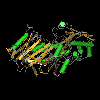 |
?cl01709: PBP2_NikA_DppA_OppA_like Superfamily (this model, PSSM-Id:294989 is obsolete and has been replaced by 445520)
 
The substrate-binding domain of an ABC-type nickel/oligopeptide-like import system contains the type 2 periplasmic binding fold This family represents the periplasmic substrate-binding domain of nickel/dipeptide/oligopeptide transport systems, which function in the import of nickel and peptides, and other closely related proteins. The oligopeptide-binding protein OppA is a periplasmic component of an ATP-binding cassette (ABC) transport system OppABCDEF consisting of five subunits: two homologous integral membrane proteins OppB and OppF that form the translocation pore; two homologous nucleotide-binding domains OppD and OppF that drive the transport process through binding and hydrolysis of ATP; and the substrate-binding protein or receptor OppA that determines the substrate specificity of the transport system. The dipeptide (DppA) and oligopeptide (OppA) binding proteins differ in several ways. The DppA binds dipeptides and some tripeptides and is involved in chemotaxis toward dipeptides, whereas the OppA binds peptides of a wide range of lengths (2-35 amino acid residues) and plays a role in recycling of cell wall peptides, which precludes any involvement in chemotaxis. Similar to the ABC-type dipeptide and oligopeptide import systems, nickel transporter is comprised of five subunits NikABCDE: the two pore-forming integral inner membrane proteins NikB and NikC; the two inner membrane-associated proteins with ATPase activity NikD and NikE; and the periplasmic nickel binding NikA, which is the initial nickel receptor that controls the chemotactic response away from nickel. Most of other periplasmic binding proteins are comprised of only two globular subdomains corresponding to domains I and III of the dipeptide/oligopeptide binding proteins. The structural topology of these domains is most similar to that of the type 2 periplasmic binding proteins (PBP2), which are responsible for the uptake of a variety of substrates such as phosphate, sulfate, polysaccharides, lysine/arginine/ornithine, and histidine. The PBP2 bind their ligand in the cleft between these domains in a manner resembling a Venus flytrap. After binding their specific ligand with high affinity, they can interact with a cognate membrane transport complex comprised of two integral membrane domains and two cytoplasmically located ATPase domains. This interaction triggers the ligand translocation across the cytoplasmic membrane energized by ATP hydrolysis. Besides transport proteins, the PBP2 superfamily includes the ligand binding domains of ionotropic glutamate receptors, LysR-type transcriptional regulators, and unorthodox sensor proteins involved in signal transduction. |
|
|
|
|
 |
